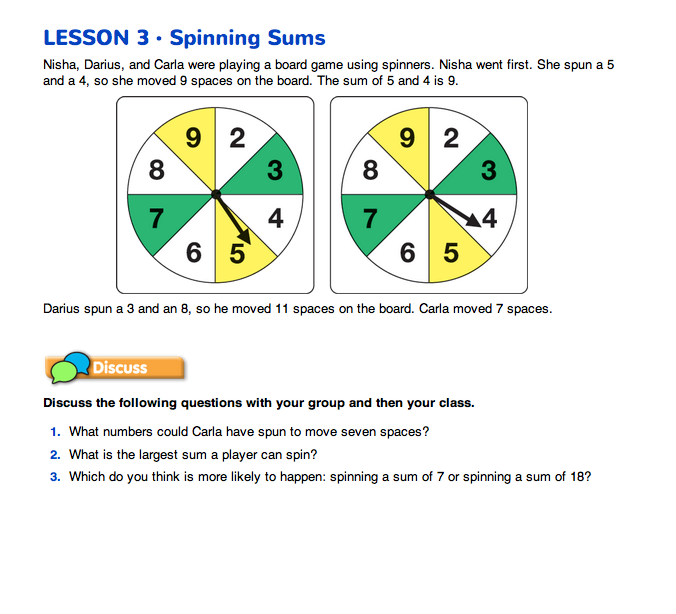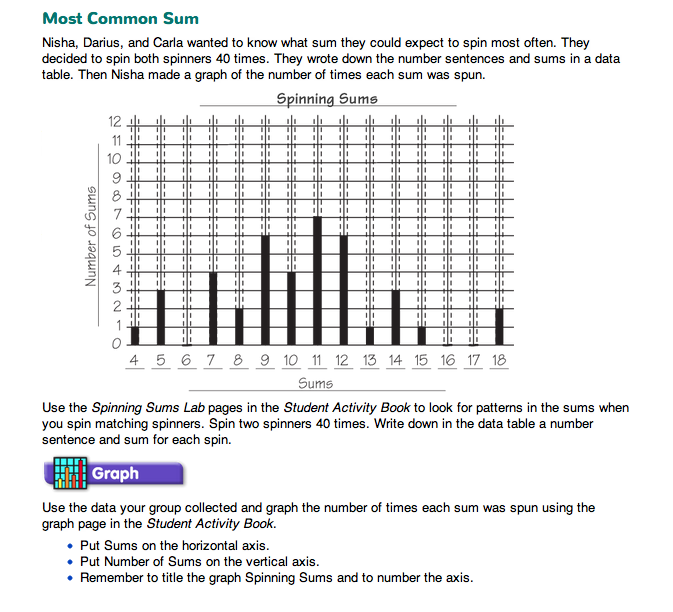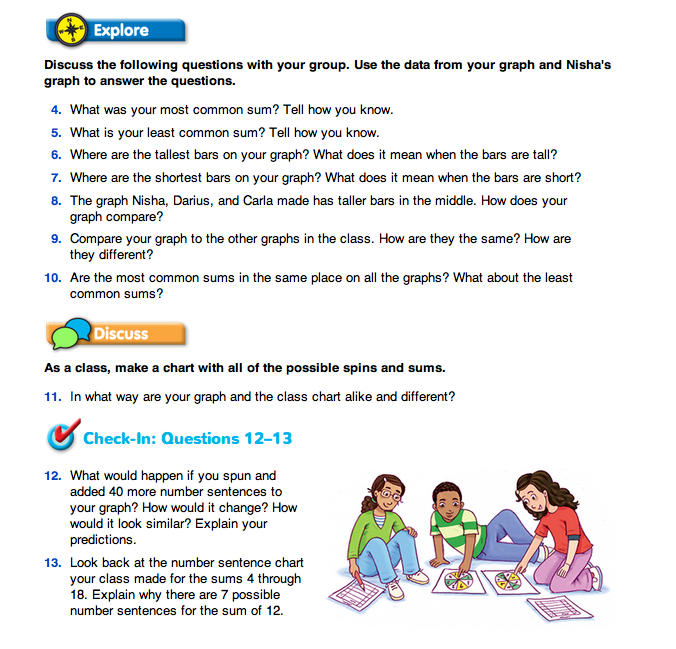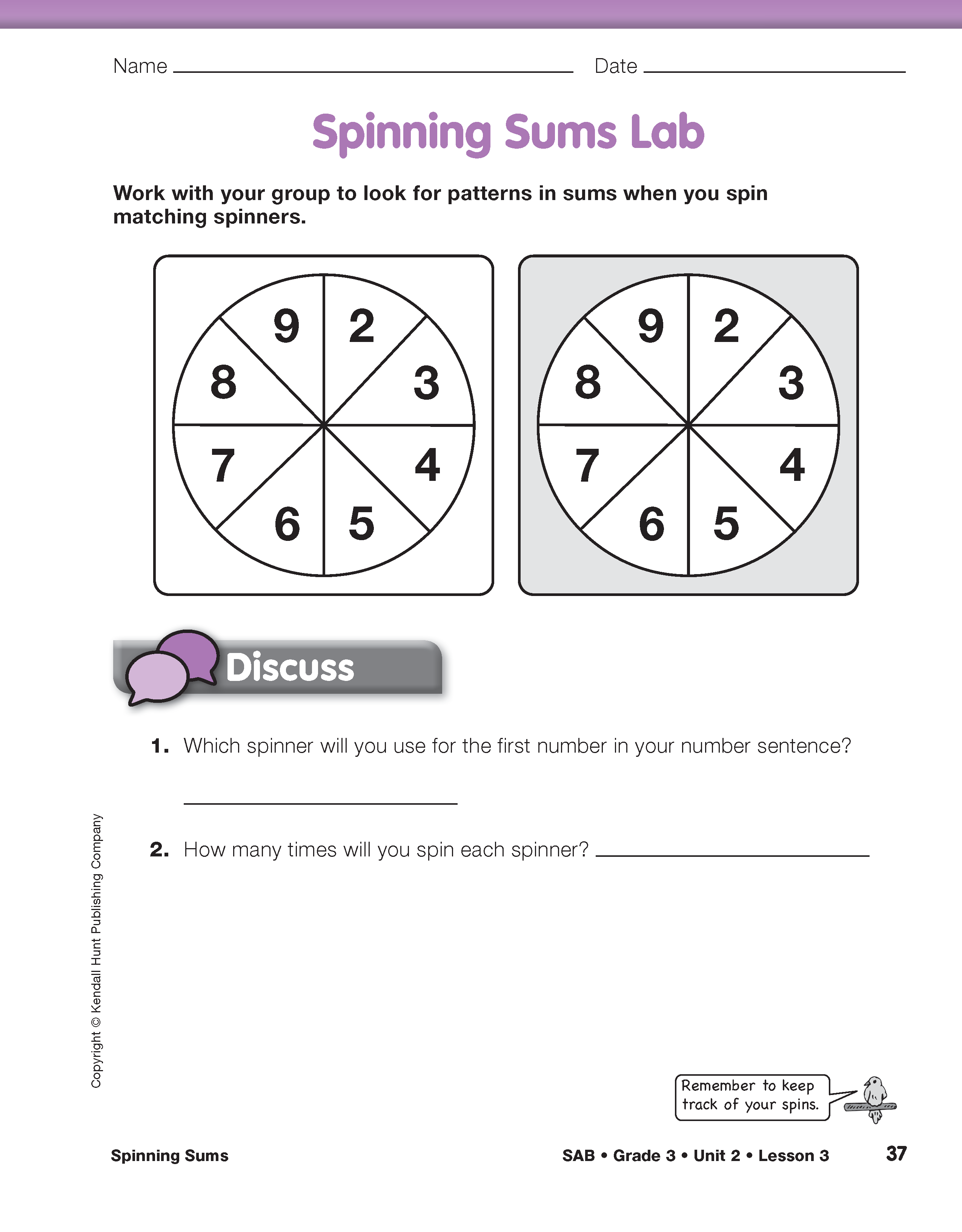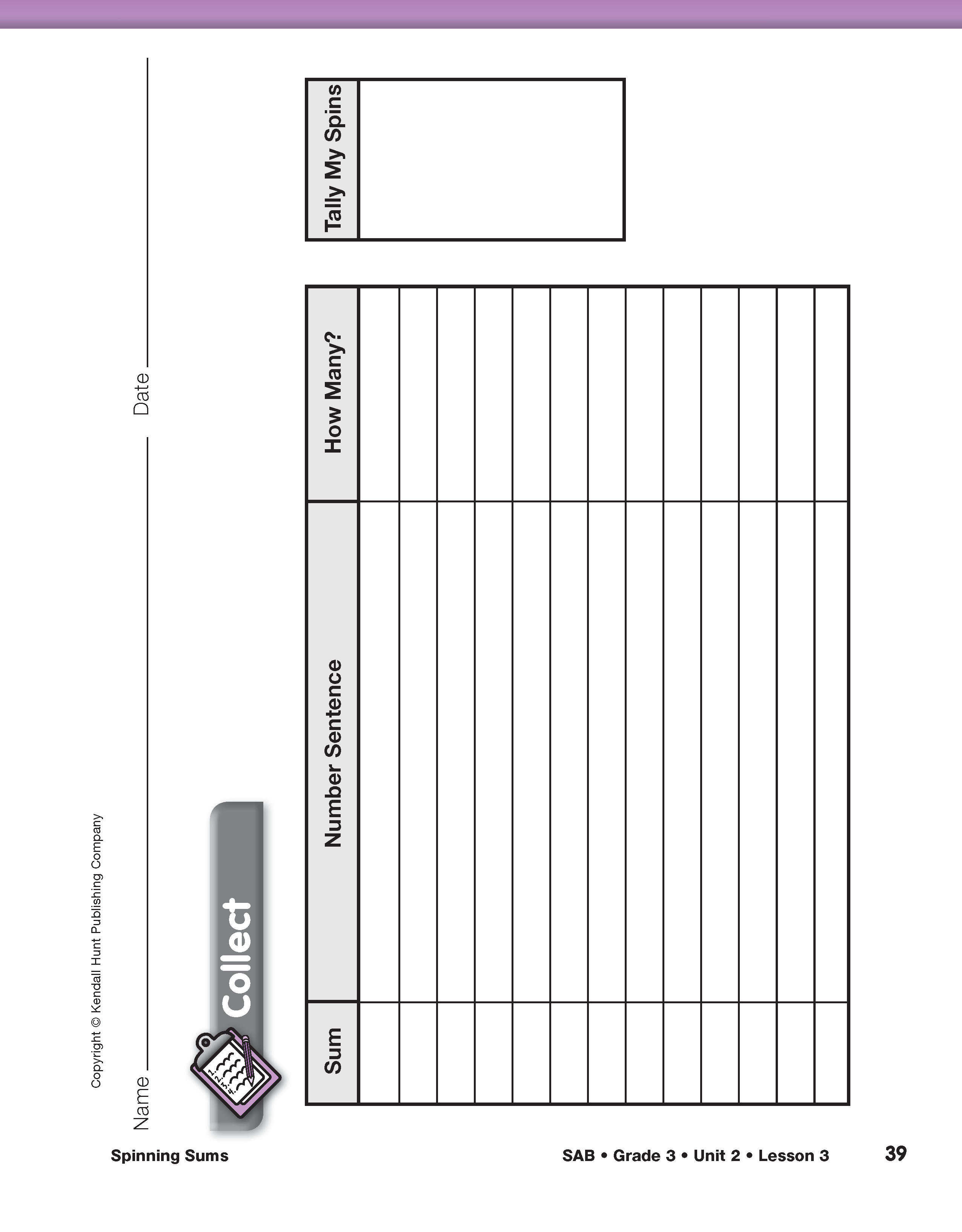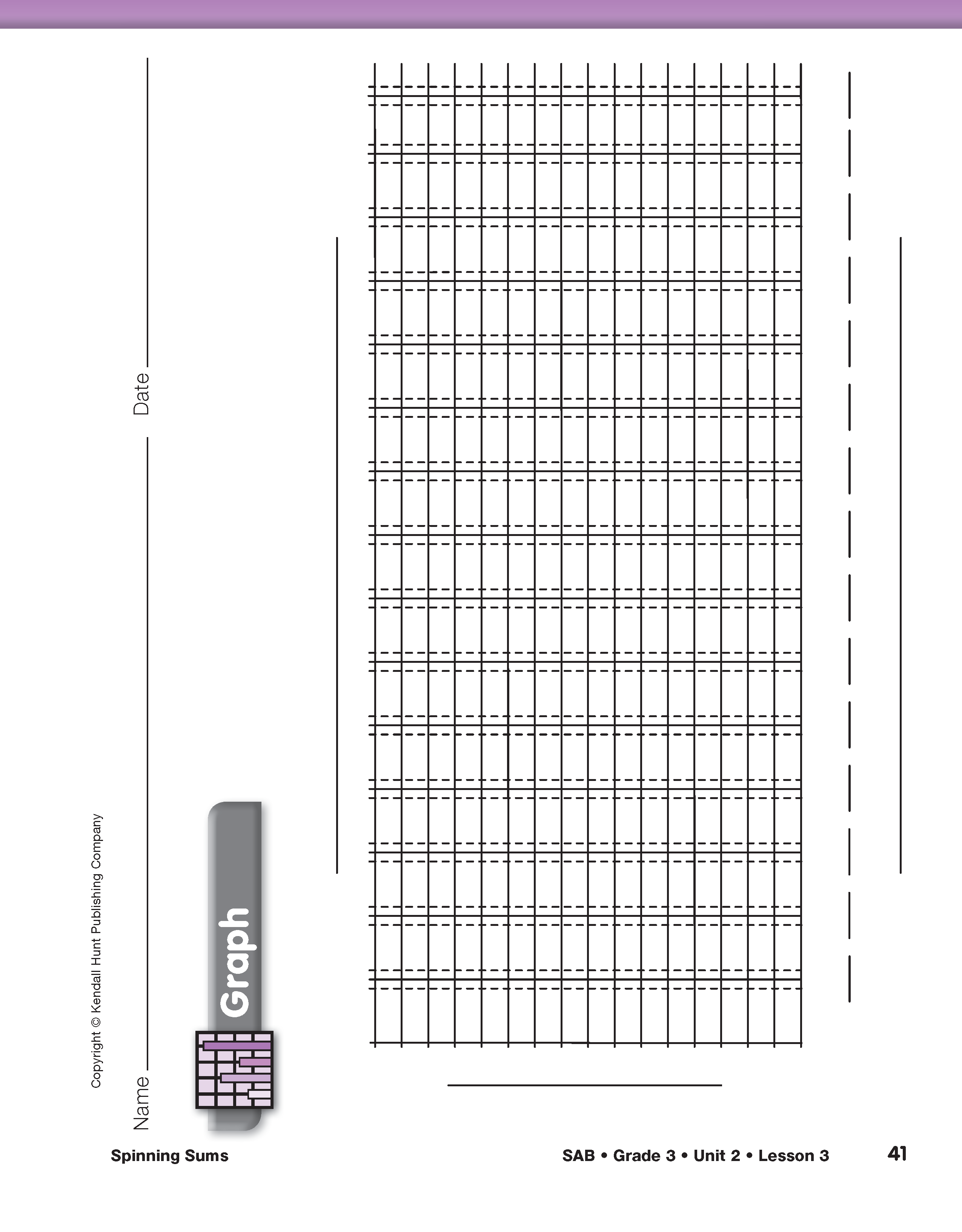Introduce Spinning Sums. Introduce the context for this lesson by reading and discussing the vingette on the first Spinning Sums page in the Student Guide.
The facts 3 + 2 = 5 and 2 + 3 = 5 are sometimes called turn-around facts, i.e., facts that are identical except for the order of the addends. This is an example of the commutative property of addition; in an addition problem, the order of the addends will not change the sum. Although both number sentences have a sum of 5, in this investigation, consider them as two different number sentences. This is done because all possible number sentences that result in each sum need to be counted in order to answer questions such as, “What is the most common sum?” A sum of 5 is theoretically twice as likely to be spun as a sum of 4, since there are two ways to spin a 5 (2 + 3 and 3 + 2) and only one way to spin a 4 (2 + 2).
Read the introduction, and then provide time for students to discuss Questions 1–3 in pairs or small groups. Remind students that a sum is the answer to an addition problem. Ask students to share what they discussed. Answers to Question 1 should include all of the turn-around facts among the possible number sentences for Carla's spins:
5 + 2 = 7, 2 + 5 = 7, 3 + 4 = 7, and 4 + 3 = 7.
In response to Question 2, students should recognize that the largest possible sum would result from spinning the two largest numbers: 9 + 9. Question 3 provides an opportunity to discuss why one sum might occur more often than another.
If students do not recognize that 18 is less likely because only one combination of spins can result in that sum, ask:
- How many ways could I spin a sum of 7? A sum of 18? (There are four ways to spin 7, and there is one way to spin 18.)
- Is there a way we could find out which sums are more and less likely using these spinners? (Possible response: spinning multiple times will help us find out which sums are spun most and least often.)
Refer students to the graph that Nisha, Darius, and Carla created in the Most Common Sum section.
- What is the most common sum? (11 is most common.)
- What is the least common sum? (6, 16, and 17 did not come up at all.)
- The students did not spin a sum of 16. Is this sum possible? What could you spin to get a sum of 16? (Yes, 7 + 9, 9 + 7, or 8 + 8.)
- How many times did the students spin? (40 times.)
- How do you know? (The description above the graph says they spun 40 times, but I also added up the number of sums, and there are 40 sums.)
Collect Section. Display the data table from the Spinning Sums Lab in the Student Activity Book, and use the following prompts to elicit student ideas about how to fill in the table as they gather sums from the spinners:
- What is the smallest sum possible? How do you know? (Since 2 is the smallest number on both spinners, the smallest sum is 4.)
- We found earlier that the largest possible sum is 18. Is it possible to spin all of the sums in between? (Yes.)
- What should we record in the column labeled “Sum”? (Numbers from 4 to 18, since these are the only possible sums.)
Ask students to remove the data table page from their Student Activity Book and to complete the “Sum” column on their data table. Do the same on a display of the data table.
Demonstrate Spinning Sums. Show students the two spinners on the Spinning Sums Lab pages in the Student Activity Book. Explain that they will use these two spinners to create their number sentences. Ask the class to decide which spinner—the gray one or the white one—they will use for the first number in the number sentence and which for the second. It is important that this relationship remain the same throughout the investigation.
Ask two students to demonstrate how to spin both spinners and use the numbers to write a number sentence. The most efficient way to do this is to have both students spin their spinner at the same time rather than spinning them one at a time. After each spin, show students how to record the data.
Record the number sentence in the middle column of the row that reflects its sum. Students will need to decide whether to record complete equations (4 + 3 = 7) or simply number sentences (4 + 3) in the “Number Sentences” column. Complete equations may contribute to fluency with the facts, while number sentences may leave more space and make recording the data simpler. Either is acceptable as long as all students follow the same procedure.
Students must record and count all possible number sentences that result in each sum in order to determine which sum is the most common and which sum is the least common.
Pose the following scenarios by asking:
- If I spun a 2 on the first spinner and [student's name] spun a 3 on the second spinner, how would I record that on the data table? (2 + 3 = 5 or 2 + 3)
- On my next spin, if I spun a 3 and [student's name] spun a 2 on the second spinner, how would I record that on the data table? (3 + 2 = 5 or 3 + 2)
- 2 + 3 and 3 + 2 are turn-around facts, so they both give a sum of 5. Do I need to record each of them, or can I just write one number sentence? Explain. (You need to record 2 number sentences, one for each spin, because we want to see how many times we spin a certain sum. We got a sum of 5 twice.)
- What if we spin again and get a 2 and a 3 again? (Record 2 + 3 on the data table again. Every spin's number sentence needs to be recorded.)
Students will be spinning 40 times, and therefore recording 40 number sentences. To better keep track of the 40 spins, a tally mark should be recorded in the “Tally My Spins” box on the data table page. After 40 spins, students will complete the last column in the data table.
As students create graphs and answer the questions following the data collection, it may be helpful for each to have his or her own copy of the data table. Allow time for students to transfer the data to their own data table.
Groups Collect Data. Organize students into groups of three to collect data: two will be spinning, and one will record number sentences and keep a tally of the spins.
Remind students of their earlier decision to use one spinner (gray or white) for the first number in each number sentence. It is important to follow this convention consistently. After 40 spins, have students count the number of number sentences for each sum and record that number in the “How Many?” column of the data table.
The data reflected in the graph on the Spinning Sums page in the Student Guide is shown in Figure 2. Note that students recorded the number sentence 3 + 6 = 9 three times since they spun it three times.
Graph Data. Remind students that you are trying to find out how many times sums are spun so that you can make comparisons and that they will make a graph to display their data. Students will use the bar graph from the Spinning Sums Lab pages in the Student Activity Book. There is an extra graph on the backside of that page. Directions for preparing the graph are in the Graph section of the Spinning Sums page in the Student Guide.
- Look at your data tables. How should we number the horizontal axes? (4 through 18)
- How should we number the vertical axes? (By ones; we did not get totals of more than 10 sums.)
When graphs are complete, assign Questions 4–8 in the Student Guide to student pairs or small groups.
A brief “gallery walk” is a great way for students to see the graphs made by other groups. Display the graphs for everyone to see, and ask groups to walk past them looking for similarities and differences.
Create Class Number Sentences Chart. In Questions 9 and 10, students are asked to compare their graph to other graphs in the class.
- Do you notice anything that is alike about all of our graphs? (The highest bars tend to be in the middle; the shortest bars tend to be at either end.)
If students do not notice this pattern, set the question aside and ask it again after creating the class chart.
If students do notice this pattern, ask:
- Why do you think the most common sums and least common sums are clustered like this?
To answer this question, help the class make a number sentence chart which, when completed, will look like the one in Figure 3.
To build the chart, you will need to write the sums 4 through 18 in order along the bottom of a sheet of chart paper on which you will create the chart. Ask questions to elicit from students all of the possible number sentences that could be spun for each sum, recording them above the sum as students report them. Begin with the sum of 4 and continue in order, using the Sample Dialog 1 as a guide.
Continue asking similar questions until you have recorded all number sentences for sums of 4 through 8. If a possible number sentence was not spun, ask students if it would be possible to spin it, and then add it to the chart since this is a chart of possible sums, not sums actually spun.
After completing the chart for the sum of 8, give students time to discuss the following question with a partner, before asking volunteers to share what they discussed.
- Do you notice a pattern in our chart? Can you describe it? (The number of combinations for each sum is increasing by 1.)
- Can you use this pattern to predict how many number sentences there will be for 9? For 10? (There will be six ways to spin 9 and seven ways to spin 10.)
Record the number sentences for the class chart on self-adhesive notes as students report them. The notes can then be rearranged to make the chart easier to read or put in an order that makes the patterns easier to see.

This dialog provides on example of teacher prompts and possible student responses that can be used to begin building the class chart.
Teacher: Did any group spin two numbers whose sum is 4?
Student: Yes, we got 2 + 2 = 4. [Teacher records 2 + 2 above 4 in the chart].
Teacher: Did anyone get 4 a different way?
Student: No.
Teacher: Why do you think no one else spun 4 a different way?
Student: There is no other way to spin 4 with these spinners.
Teacher: Did anyone spin a number sentence starting with 2 that had a sum of 5?
Student: Yes, 2 + 3 = 5. [Teacher records 2 + 3 above 5 in the chart.]
Teacher: Are there any number sentences with a sum of 5 that start with 3?
Student: Yes, 3 + 2 = 5. [Teacher records 3 + 2 above 5 in the chart.]
Teacher: Did anyone spin another number sentence with a sum of 5?
Student: No.
Teacher: Why do you think no one else found another way to spin a sum of 5?
Student: Because the only other ways would be with 1 and 4, or 5 and 0, and our spinners do not have a 1 or a 0.
Continue to build the class chart for the sums of 9 and 10 asking questions similar to those in Sample Dialog 1 so that all of the possible number sentences are recorded. The chart should include six number sentences for the sum of 9 and seven number sentences for the sum of 10. As you continue the table, students are very likely to continue to predict an increase of one number sentence per sum, since this is the pattern they have seen so far. In reality, however, the number of possible number sentences decreases by 1 starting with the sum of 12. Develop this idea with further discussion, as described in Sample Dialog 2.

The dialog in this box provides sample teacher prompts and possible student responses that can be used as you complete the class chart.
Teacher: Now, predict how many number sentences there will be for 10.
Student: There will be one more. I guess there will be seven ways to get 10. [Teacher writes down the number sentences for 10 as the class tells them to her.]
Teacher: Were we right?
Student: Yes!
Teacher: How many number sentences will there be for 11?
Student: I bet there will be eight number sentences for 11. [Teacher writes the number sentences for 11 as the students list them and continues the same process for 12, asking the students for a prediction and then checking it. There are seven ways to get a sum of 12.]
Teacher: Predict the number of sentences for 12.
Student A: If the chart keeps going up, there will be nine.
Student B: No, I think it's going to go down like it did on our graph. Eleven is in the middle. The highest points on our graphs were in the middle.
Teacher: Let's see if the chart will go up or down. [Writes down the seven number sentences for 12. The chart begins to look like a pyramid.] You were right. The number of sentences for 12 was less than the number of sentences for 11. Predict the number of sentences with a sum of 13.
Student: It will keep going down. There will be six number sentences. [Teacher writes the six number sentences for 13, and then continues as before until the chart is complete.]
Look for Patterns in the Sums. When the chart is complete, outline each column so that the chart looks like a bar graph. Explain to students that if we were to make a bar graph of the number of possible ways to spin each sum, this is how the bars would look. Ask students to look back over the class chart asking the following questions to guide a discussion about the possible number sentences for each sum.
- Why do you think our chart has this shape? (There are more ways to spin the sums in the middle, so the bars are higher. There is only one way to spin the 4 and the 18, so the bars are the lowest at the two ends.)
- Look at the number sentences for the sums of 4 and 18. What do you notice about the number sentences? (There is only one number sentence for each of these sums, and the number sentences are doubles, so there is only one way to write them.)
- Look at the number sentences for all of the other even-number sums. What patterns do you notice? (There are always an odd number of number sentences. One of the number sentences is always a double, and each of the other ones has a turn-around fact, like 4 + 2 = 6 and 2 + 4 = 6.)
- Look at the number sentences for all of the odd-number sums. What patterns do you notice? (When the sum is an odd number there is an even number of number sentences. Each number sentence also has a turn-around fact. There are no number sentences that use doubles.)
After completing this discussion, ask students to work with their small group to look back at the graph they made from their data table to answer Question 11 in the Student Guide.
















